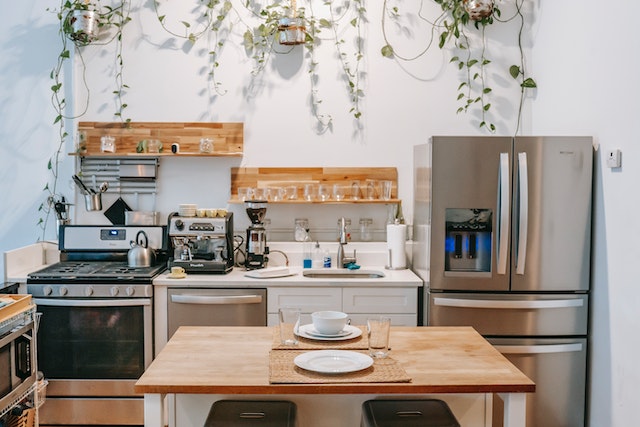This is an excerpt from the Book called “New Kitchen Ideas That Work” by Jamie Gold. Continue reading to learn more about Cooking Ventilation and Tools, thanks to the author
Table of Contents
ToggleCooking Ventilation
Cooking ventilation is crucial for your health, safety and the overall comfort of your home. It pulls odors, grease and gases out of your kitchen and house through properly connected ducts. Ducting outside from a wall, cabinets, or ceiling mounted ventilation unit over the cooking surface is the ideal, but isn’t always possible in condo projects or more affordable remodels.
Some island or peninsula cooktop installations are paired with downdraft ventilation. If the kitchen sits over a crawlspace or basement rather than the commonly found concrete slab foundation, these may also be ducted outside. In general, though, downdraft vents are less efficient than overhead options.
For those situations when you absolutely can’t vent outside, a recirculation kit in a downdraft system. Vent hood, or over-the-range microwave may be the only substitute. These kits pull the cooking steam, gasses, and grease through a filter, clean it somewhat, and send it back into the kitchen.
Given the importance of including cooking ventilation in your kitchen plan, it’s no surprise that it has evolved into a crucial style choice, as well as a performance component. Some design plans call for hidden ventilation. This could take the shape of a downdraft model retracting into the countertop or a wall-mounted insert hiding behind millwork, stonework, or even inside a cabinet.
Other plans use a decorative vent hood as a design focal point. There is a wide range of styles and materials available to create your look. Contemporary kitchen may call on sleek steel and glass, whereas traditional spaces could opt for hammered copper or a custom-painted hood to match a vintage-style range.
Whichever design direction you go, it’s important to choose an insert or hood that meets the size and ventilation specifications for your cooking surface and that conforms to local building codes. Most important is that you actually use it while you’re cooking (Choose the quietest model you can afford, so that you’re not tempted to leave it off or have to shout over it).

Cooking Tools
RANGES
$ TO $$$
- Combine a cooking surface and one or more ovents into a single 24-inch or larger appliance with four to eight burners and accessories. The most common size is 30 inches.
- Cooking surface can be gas, electric, or induction, and ovens can be gas or electric. Dual-fuel model include gas cooktops and electric ovens.
- Cooktop accessories for 36-inch and larger ranges can include grills, griddles, or wok burners.
- Ranges may include double ovens, convection ovens, or warming drawers, even in standard 30-inche models.
- Ranges are typically offered in freestanding models with the controls on a raised panel behind the burners or in slide-in versions with controls in the front and no raised back panel.
- Stainless steel has been the leading luxury finish for many years, but is about to be joined in that category by glass-front appliances, especially smartphone-inspired white and black versions.

Cooktops
$ to $$$
- Cooktops can sit directly on the countertop with top-mounted controls or, in a range-top configuration, extend into the cabinetry front below with front-mounted controls.
- Like the burners on a range, these units can be gas, electric, or induction. There are also modular units that allow you to combine cooking types by pairing different burner modules.
- Most common sizes for electric and induction cooktops are 30inch and 36 inch. Gas is the most popular option for the larger 48-inch and 60-inch models.
- Grills, griddles, and woks are popular cooktop add-on features.
- Induction cooktops are the most energy-efficient and easier to clean.

Wall Ovens
$$ to $$$
- Wall ovens come in single or double models. Singles are often mounted below a cooktop.
- Combination wall ovens pair a standard or convection oven with a convection microwave oven for added functionality.
- Although called wall ovens, singles often mount in a base cabinet, whereas doubles usually mount in tall cabinets.
- Convection and speed-cooking features are increasingly popular in wall ovens. Some models may also include a pizza mode designed to produce the extra heat associated with brick ovens or steam for healthy cooking and reheating.

Microvaves and Steam Cookers
$ To $$$
- Microwave ovens are available in countertop models, built-in models with trim kits, over-the-range models with vent fans, and drawer models that mount below countertops.
- Many microwaves today offer such multitasking functions as speed-cook, convection, and warming capabilities.
- Steam cookers perform most of the same defrosting, speed cooking, and reheating functions as microwaves, with the exception of making microwave popcorn. They may be mounted in cabinetry like ovens or installed in countertops. They may be connected to the home’s plumbing lines or function independently with built-in reservoirs.

